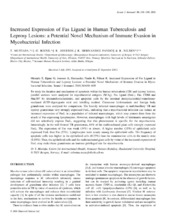Increased Expression of Fas Ligand in Human Tuberculosis and Leprosy Lesions: a Potential Novel Mechanism of Immune Evasion in Mycobacterial Infection
Peer reviewed, Journal article
Permanent lenke
https://hdl.handle.net/1956/2066Utgivelsesdato
2001-12Metadata
Vis full innførselSamlinger
Originalversjon
https://doi.org/10.1046/j.1365-3083.2001.01020.xSammendrag
To study the location and mechanism of apoptosis within the human tuberculosis (TB) and leprosy lesions, parallel sections were analyzed for mycobacterial antigens (M.Ag), Fas ligand (FasL), Fas, CD68 and Mac387 by immunohistochemistry, and apoptotic cells by the terminal deoxynucleotidyl-transferase-mediated dUTP-digoxigenin nick end labelling method. Cutaneous leishmaniasis and foreign body granulomas were analyzed for comparison. The heavily infected macrophages in multibacillary TB and leprosy granulomas very strongly expressed FasL, indicating that a mycobacterial infection can induce an increased expression of FasL in a population of infected macrophages, which may protect them from the attack of Fas-expressing lymphocytes. However, macrophages with high levels of leishmania amastigotes did not selectively express FasL, suggesting that this phenomenon is specific for the mycobacteria. Interestingly, in the well-formed TB granulomas, 84% of the multinucleated giant cells strongly expressed FasL. The expression of Fas was weak (34%) or absent. A higher number (33%) of epithelioid cells expressed FasL than Fas (23%). Lymphocytes were scanty among the epithelioid cells. The frequency of apoptotic cells was higher in the epithelioid cells (0.25%) than the mononuclear cells in the mantle zone (0.14%). Thus, the epithelioid cells and the multinucleated giant cells by virtue of the increased expression of FasL may make these granulomas an immune privileged site for mycobacteria.
